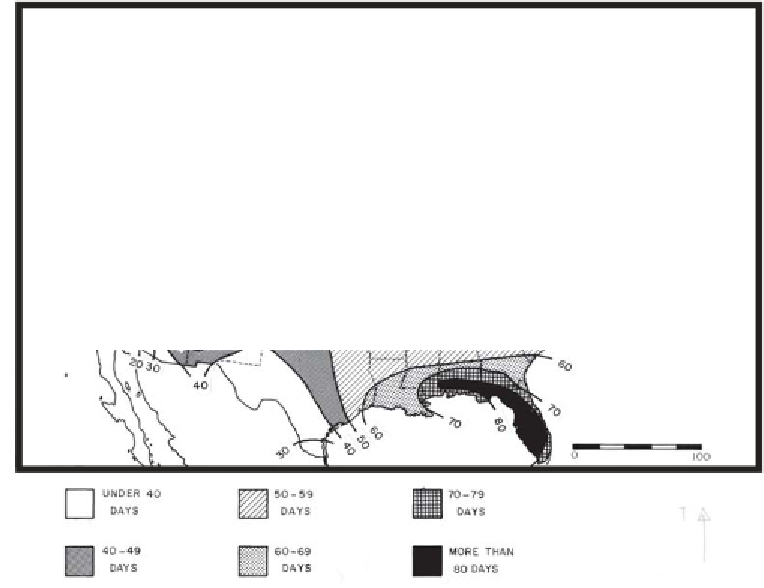Geoscience Reference
In-Depth Information
topography, or by the spatial arrangement of pressure
patterns, can also initiate uplift. The most likely occur-
rence of instability takes place along cold fronts, mainly
the polar front where it intrudes into moist tropical air.
Such intrusions are common over the United States
Midwest and along the south-eastern part of Australia.
Figure 4.1 illustrates all of the above processes over
the United States. The highest incidence of thunder-
storms - greater than 60 per year - occurs in Florida,
which is dominated by tropical air masses, especially in
summer. A smaller area of high thunderstorm fre-
quency over the Great Plains corresponds to an area
affected by topographic uplift. From here across to
the east coast, thunderstorm activity occurs because
of the interaction of polar and tropical air. In Australia,
the distribution of thunderstorms follows a similar
pattern (Figure 4.2). The greatest intensity of storms -
greater than 30 per year - occurs in the tropics and
along the eastern Divide, where topographic uplift is
favored. In terms of forcing thunderstorm develop-
ment, the passage of cold fronts plays a minor role in
Australia compared to the United States. While the
incidence of storms in Australia is less than in
the
Australia are some of the most intense in the world.
They have been referred to as stratospheric fountains
because their associated convection is strong enough to
pierce the tropopause and inject air from the tropo-
sphere into the normally isolated stratosphere. This
process is highly effective during periods when Walker
circulation is 'turned on'.
Thunderstorms globally generate electricity between
a negative ground surface, and a more positively
charged
electrosphere
at about 50 km elevation. Tropical
thunderstorms are responsible for most of this upward
current of electricity, each averaging about 1000
amperes (A). This current creates a positive charge in
the ionosphere reaching 250 kV with respective to the
ground. There is, thus, a voltage gradient with altitude.
A steepening of this gradient enhances thunderstorm
activity. This can be accomplished by increasing the
amount of atmospheric aerosols such as smoke from
bushfires, pollution, or thermonuclear devices. The
gradient can also be increased by solar activity through
the interference of the solar wind with the Earth's
magnetic field. During sunspot activity, the electro-
sphere becomes more positively charged, increasing
the frequency of thunderstorms. Thus thunderstorm
United States, thunderstorms over tropical
50
4
0
0
1000 km
<40
days
50-59
days
70-79
days
40-49
days
60-69
days
>80
days
Annual frequency of thunder days in the United States (from Eagleman, 1983).
Fig. 4.1


























































